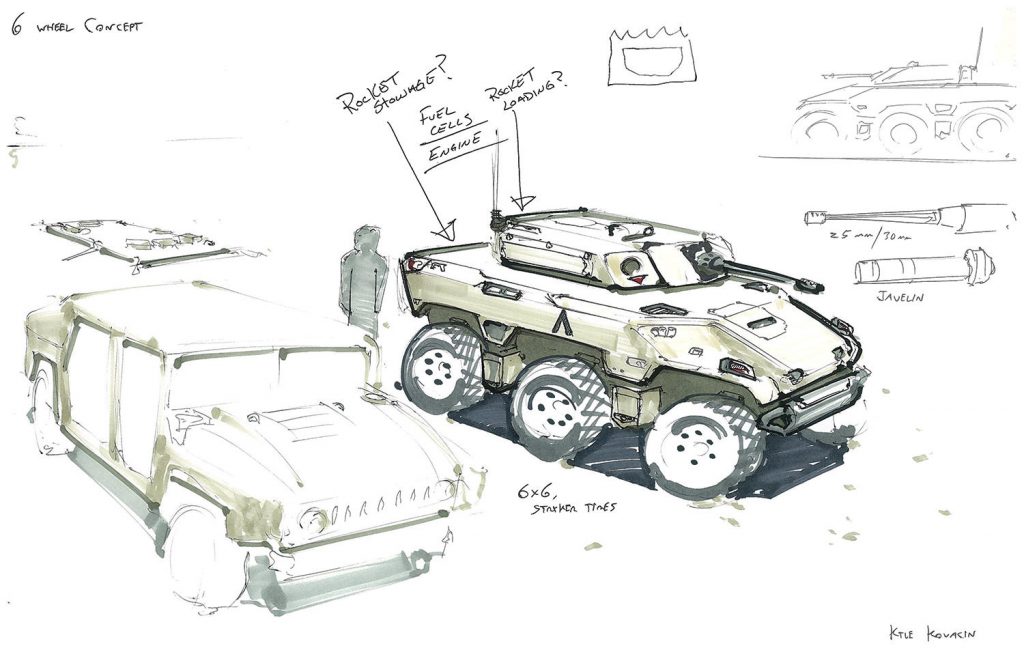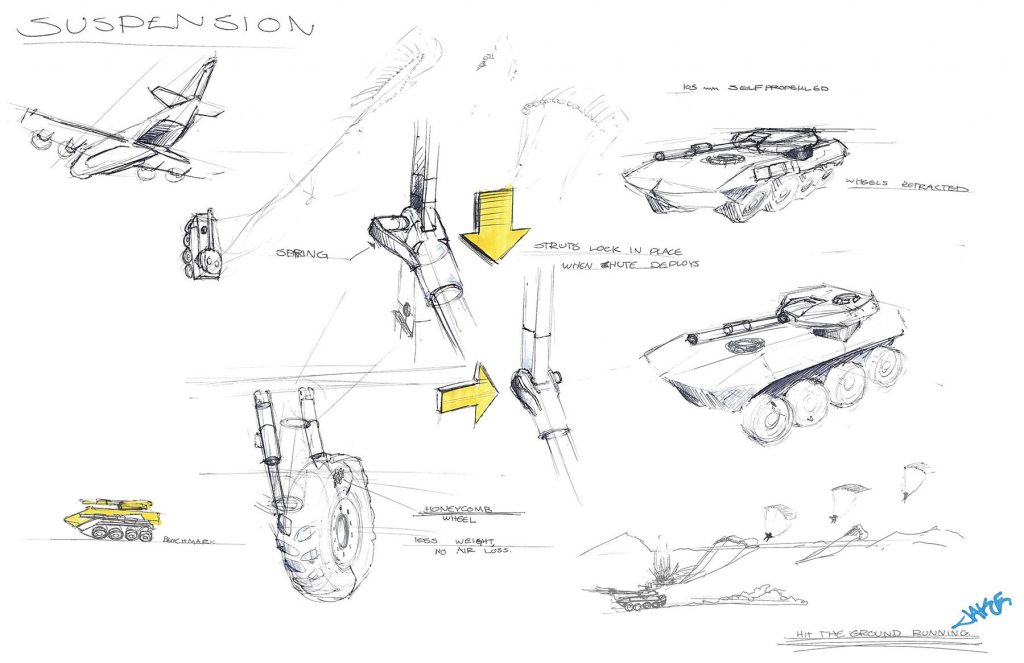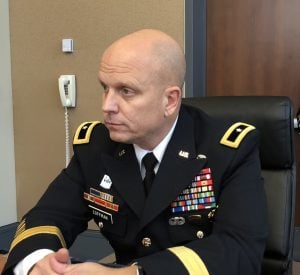
An Army soldier’s sketch for a future armored fighting vehicle.
WASHINGTON: Is fourth time the charm? After three failed attempts to replace the Reagan-era M2 Bradley troop carrier with better tech for modern warfare, the Army has a bold new strategy – one that could include a government design team competing head-to-head against contractors.
The draft Request For Proposals (RFP), released Friday, raised some eyebrows in industry. But in an exclusive interview with Breaking Defense, Army officials told me a government team should stimulate, not stifle, much-needed innovation and competition.
“We recognize that this does generate some concerns about potential organizational conflicts of interest,” said James Schirmer, the Deputy Program Executive Officer for Ground Combat Systems. “We certainly take those seriously.”
The potential government team is now developing a formal “Organizational Conflict of Interest Mitigation Plan,” creating organizational firewalls so the Army team can’t influence the requirements or selection process, Schirmer told me. If that plan doesn’t pass muster with Army lawyers, he said bluntly, “then we would be prohibited from awarding a contract to the government team.”

James Schirmer
What Can The Army Add?
But why bother jumping through all these legal and administrative hoops to get the government team in the mix, I asked, when other top-priority programs, from high-speed helicopters to precision-guided rifles, rely entirely on industry?
“To my knowledge, there’s not a direct example of something similar occurring,” Schirmer agreed. But armored combat vehicles are a uniquely military design problem with few equivalents in the commercial world.
“If you look at small arms, while we do have expertise in-house, there’s a commercial industry that is very, very similar to the small arms that we’re procuring for the military,” Schirmer told me. “If you look at aviation, while there’s obviously some very important differences with military aircraft versus civilian ones, there’s an awful lot of similarities.”
“On the combat vehicle side, they’re aren’t as many similarities,” he said. “The engines that we use in commercial trucking can’t survive under armor without cooling…. Our suspension systems are not unlike some commercial construction equipment, but we drive our vehicles at much higher speeds and are generally much heavier.”
Meanwhile, Army scientists and engineers have spent decades studying everything from engines to armaments, from automated targeting systems to complete concepts for new vehicles. “We’ve got government folks that are really experts on combat vehicles and have good ideas,” Schirmer told me. “This phase primarily is generating ideas… potentially some innovation from inside our own halls.”

An Army soldier’s sketch for a future armored fighting vehicle.
That said, Schirmer didn’t rule out the possibility that a government team might compete in later phases of the program – not just in developing “preliminary digital designs,” the subject of the draft RFP, but potentially in building a physical prototype vehicle as well. Actual mass production, however, would definitely be up to the private sector.
“The government’s got the ability to build prototypes,” he said. “The challenge would be the transition from an EMD [Engineering & Manufacturing Development]-like prototype into a production asset. That’s something, typically, the government has not done.”
So, he said, “the government team might need some help in that phase.” A government team might need help crafting a sufficiently detailed design that a contractor could actually build a working vehicle from it. Conversely, the manufacture would have to set up their supply chain and production line without the benefit of having done a prototype beforehand.
“We’d have to figure out how we do that if the government were to continue as a competitor,” Schirmer said. “But to be honest, we have not thought beyond this phase” in any detail.
Remember, the Army’s still seeking industry feedback on the draft RFP; it has until next year to revise and finalize it. So at this point, it’s not certain that a government team will even enter the current phase of the competition, let alone win a contract to develop the preliminary digital design.
“We have room to award up to five contracts,” Schirmer said. “Even if the government team is one of those, there will be four additional contracts for industry.”
“There’s plenty of room for industry to get in and win,” he said. “I don’t think they’re going to be at a disadvantage relative to … the government team.”
Industry experts and insiders weren’t so sure.

Bill Greenwalt
Skeptics Speak Out
“Let’s face some reality first,” said Bill Greenwalt, an acquisition veteran who’s worked in both the Pentagon and Congress. “There is no way the Army can effectively mitigate conflict of interest with a government design team, and there is no way that the government team will not have an advantage, through access to information flow within the Army’s chain of command not available to the private sector.”
After three previous failed attempts to replace the Bradley – FCS, GCV, and the first version of OMFV – the Army rebooted the Optionally Manned Fighting Vehicle program and tried to give industry wide leeway to come up with solutions, instead of prescribing rigid requirements. But with the new mandate for a two-man crew and the proposal for a government design team, Greenwalt lamented, “just when the Army has finally asked industry to come up with a solution rather than dictate it to them, it seems they have signaled what they really want to do is dictate the solution.”
“Unfortunately, for decades, the Army has [been] wanting to return to the pre-World War II arsenal system where they controlled everything but were woefully un-innovative,” Greenwalt told me. “Rather than this half measure they should just nationalize the industrial base and get it over with and then see what kind of innovation they come up with.”
Two industry sources, who asked to remain anonymous, expressed similar skepticism that the Army’s Combat Capabilities Development Center (CCDC) and its subordinate commands, particularly the Ground Vehicle Systems Center (GVSC), can pull this off.
“I anticipate the CCDC and its conglomerate of R&D facilities will think they can compete and win,” one industry source told me. “Their design will be exquisite and probably un-manufacturable.”

The M2 Bradley has been repeatedly upgraded since its introduction, but after 40 years in service, the vehicle is reaching its limits.
“The CCDC and its R&D teams are under intense pressure from Futures Command to prove their value for the voluminous funding they have received over the last 10 years,” the source continued. “Armaments Center (formerly ARDEC) has the best track record for working with industry on guns, cannons (ERCA) and ammo, but GVSC (formerly TARDEC) has an abysmal record of having any of its technology investment migrating to a fielded platform.”
“I’m not in agreement with the Army on the acquisition strategy,” another industry source told me. “They think there are companies that would welcome the government business [to mass-produce a government design]. But I’m always skeptical of a build-to-print proposal when the company doing the production has little invested in the design. The government loses out on innovation and cost in the process, because there is no incentive to improve or advance the product.”
Greenwalt put the skeptics’ bottom line most bluntly: “Private industry should think long and hard about whether to potentially waste their valuable engineering talent and bid & proposal dollars on such a competition.”
Army officials, however, argued that they’ve set the competition up to let industry participate at minimal risk.

Brig. Gen. Richard Ross Coffman
“They submit a proposal, and then the government is paying them for their initial design,” said Brig. Gen. Richard Ross Coffman, director of armored vehicle modernization at Army Futures Command. While the final value is still being worked out, each of the up to five contract awards for the next phase should include enough funding for industry to get through Preliminary Design Review (PDR) without having to invest additional money of their own.
But what if a company feels it’s not competitive without investing its own Independent Research And Development (IRAD), as General Dynamics in particular has already done over the years? “That’s a question for industry, [but] that is not the intent of the program,” Coffman told me. “We’re trying to reduce risk for industry.”
The Army wants a wide range of competitors – definitely from industry, but perhaps in-house as well – to offer the widest possible range of ideas. OMFV could resemble a Bradley rebuilt with the best available 21st century tech, or it could look nothing like a 20th century Infantry Fighting Vehicle at all.
“Industry has a choice,” Coffman said. “Industry can use a traditional IFV model… or industry can provide a different manner in which we will transport our infantrymen on the battlefield in the most dangerous places on Earth.”
“I think we’re going to see a lot of unique solutions to the problem,” he said.
The biggest technological innovation the Army’s seeking: replacing the three-man crew used in the Bradley – and almost every comparable IFV worldwide – with just two humans assisted by powerful software. Why the Army thinks that’s achievable, and why some are skeptical, is the topic for Part II of this story, coming Monday.
Head start: Early ’25 may be first flight for Black Hawk with T901 engine
Sikorsky is using remaining FARA dollars to test out the new T901 engine in anticipation of integrating it on a UH-60 M Black Hawk later this year.


























